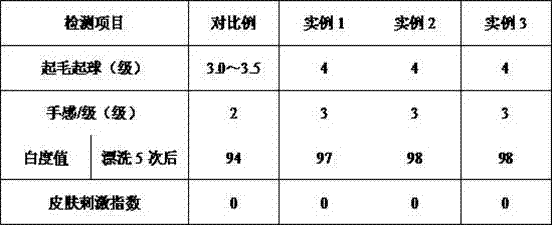Anti-pilling finishing agent of wool fabric
An anti-pilling agent and anti-pilling technology, used in fiber treatment, animal fibers, textiles and papermaking, etc., can solve the problems of poor yellowing resistance and poor wool feel, and achieve improved yellowing resistance and good performance. Membrane, reducing pilling effect
- Summary
- Abstract
- Description
- Claims
- Application Information
AI Technical Summary
Problems solved by technology
Method used
Image
Examples
example 1
[0026] Weigh the wool, put it into a wool grinder and grind it for 5 minutes, add the crushed wool to soak in absolute ethanol, filter after soaking for 8 hours, and get the filter residue, put it in an oven, and dry it at 40°C for 8 hours, according to the mass ratio of 1: 10 Add the dried filter residue to a 50% formic acid aqueous solution by mass fraction, crush it with an ultrasonic cell pulverizer for 5 minutes, and obtain a wool mixture, pass the wool mixture through a 160-mesh sieve, and collect the liquid, which is the wool enhancement liquid; In terms of parts, take 10 parts of wool, 8 parts of urea, 40 parts of 5% sodium dodecyl sulfate solution by mass fraction and 40 parts of 3% sodium bisulfite solution by mass fraction, stir and mix them and put them into the reaction kettle. Heat to 120°C under stirring condition, heat preservation and stirring for 5 hours, then cool to room temperature, discharge the material, filter to obtain the filtrate, which is the wool so...
example 2
[0028]Weigh the wool, add it to a wool grinder and grind it for 7 minutes, add the crushed wool to soak in absolute ethanol, filter after soaking for 9 hours, and get the filter residue, put it in an oven, and dry it at 45°C for 9 hours, according to the mass ratio of 1: 10 Add the dried filter residue to a 50% formic acid aqueous solution by mass fraction, and crush it with an ultrasonic cell pulverizer for 7 minutes to obtain a wool mixture, pass the wool mixture through a 170-mesh sieve, and collect the liquid, which is the wool enhancement liquid; In terms of parts, take 13 parts of wool, 10 parts of urea, 45 parts of 5% sodium lauryl sulfate solution and 45 parts of 3% sodium bisulfite solution by mass fraction, stir and mix them and put them into the reaction kettle. Heat to 130°C with stirring, keep warm and stir for 6 hours, then cool to room temperature, discharge the material, and filter to obtain the filtrate, which is the wool solution. Add the wool solution to the ...
example 3
[0030] Weigh the wool, add it to a wool grinder and grind it for 10 minutes, add the crushed wool to soak in absolute ethanol, filter after soaking for 10 hours, and get the filter residue, put it in an oven, and dry it at a temperature of 50 ° C for 10 hours, according to the mass ratio of 1: 10 Add the dried filter residue to a 50% formic acid aqueous solution by mass fraction, crush it with an ultrasonic cell pulverizer for 10 minutes, and obtain a wool mixture, pass the wool mixture through a 180-mesh sieve, and collect the liquid, which is the wool enhancement liquid; In terms of parts, 15 parts of wool, 12 parts of urea, 50 parts of 5% sodium lauryl sulfate solution by mass fraction and 50 parts of 3% sodium bisulfite solution by mass fraction were taken respectively, stirred and mixed and then put into the reaction kettle. Heat to 150°C with stirring, heat preservation and stirring for 7 hours, then cool to room temperature, discharge the material, and filter to obtain t...
PUM
 Login to View More
Login to View More Abstract
Description
Claims
Application Information
 Login to View More
Login to View More - R&D
- Intellectual Property
- Life Sciences
- Materials
- Tech Scout
- Unparalleled Data Quality
- Higher Quality Content
- 60% Fewer Hallucinations
Browse by: Latest US Patents, China's latest patents, Technical Efficacy Thesaurus, Application Domain, Technology Topic, Popular Technical Reports.
© 2025 PatSnap. All rights reserved.Legal|Privacy policy|Modern Slavery Act Transparency Statement|Sitemap|About US| Contact US: help@patsnap.com

